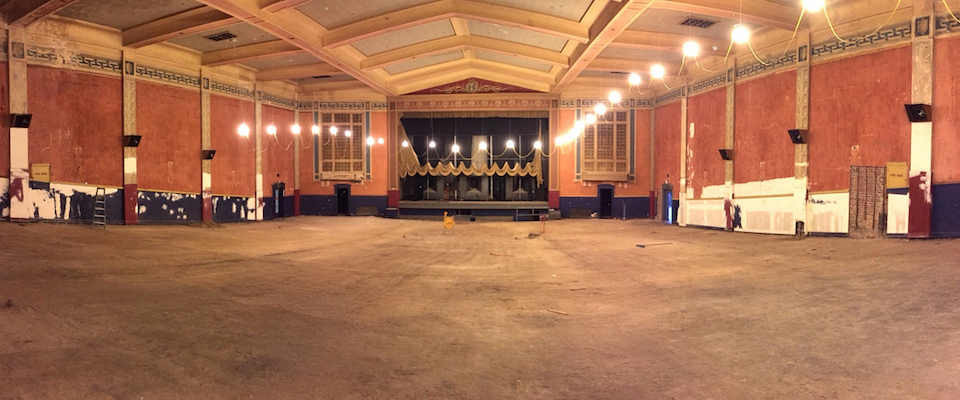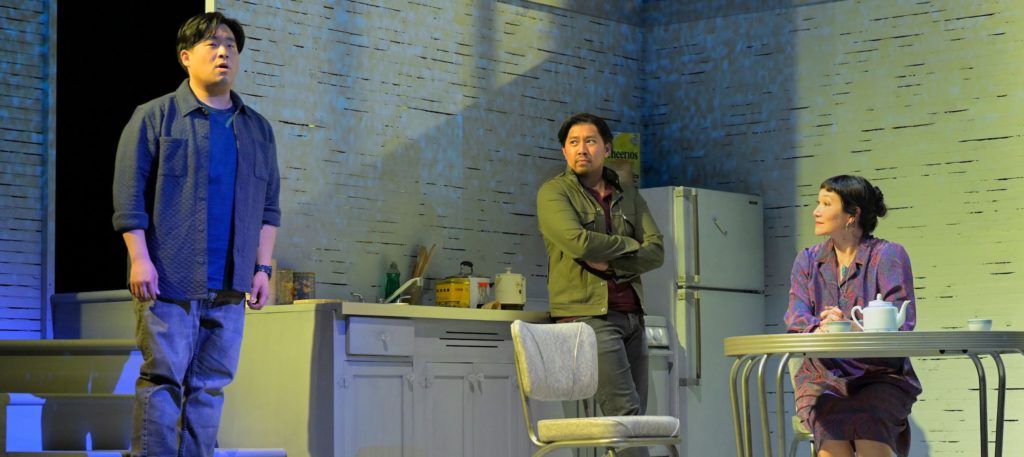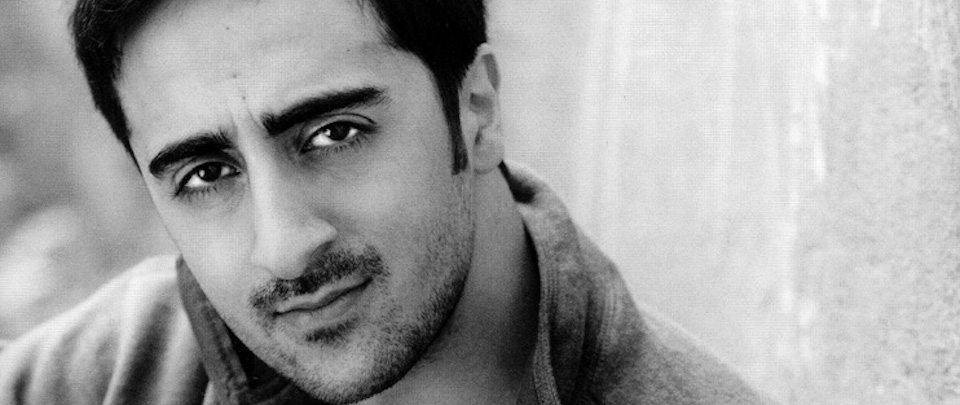On University Avenue in downtown Berkeley, they’ve erected a shiny new marquee—black, blue and gold, with white lettering that almost seems too clean for the boarded-up building and the street beneath it. Dodge the construction workers and step inside, through a modest lobby and hallway coated in old grime and fresh sawdust, until a door opens up into an enormous old theater. It feels like a huge cave or an underground palace of ancient times. The seats are gone, the floor is gutted, and every construction crash and boom feels like the echo of a long-forgotten memory. This is the legendary UC Theatre: a space seeped in history, moth-balled for 14 years, and now being resurrected as a live music and arts venue.

Today marks the official groundbreaking—or more accurately, jackhammering down to ground. If all goes as planned, in the autumn of 2015 the UC Theatre will re-emerge from its $5.5 million renovation as a new beacon of music for young and old, infusing Berkeley with much-needed energy.
Editors’ update: The reopening was delayed until the spring of 2016 and was to kick off with a sold-out performance by They Might Be Giants on Friday, March 25, and then Trombone Shorty & Orleans Avenue the following night. Both programs were cancelled at the last minute due to “power and permitting issues.”
Considering Berkeley’s rich history and claim to progressive arts, it might be surprising that over the years the city’s image as an arts-and-entertainment hub has faded. When young people want to hear music now, most of them head to Oakland or San Francisco. “It’s hard for me to even think of very many real venues in Berkeley,” says Roger Kim, a 26-year-old jazz guitarist who graduated from UC Berkeley’s Music Department in 2011. “There are more places to play in Oakland and San Francisco, and a variety of types—a lot of small, medium, and large venues.” Berkeley has venues like Ashkenaz, the Freight & Salvage Coffeehouse, the Starry Plough, and 924 Gilman, but ask any local musician in a working band and the majority of their East Bay shows are played in Oakland. Venues such as the Greek Theatre or Zellerbach Hall are often too expensive for students and young music lovers.
Even Freight & Salvage Coffeehouse, while popular with many Berkeley music lovers, “definitely [has] a reputation for having an audience that is older, whiter, wealthier, and more highly educated than the average population,” acknowledges Sharon Dolan, the Freight’s new executive director. She echoes the view of Freight program director Renée Gaumond, who says “We’re making a conscious effort to book younger bands … doing more Americana, more roots music…. There’s this new generation of young artists who are just doing incredible work that we want to showcase here, that falls within what the Freight is known for.” The Freight’s calendar now features more young, upcoming bands—and even occasional poetry slams and free or discounted events for families and students—but Dolan concedes it has “a long way to go if we’re going to be really representative of the community that we live in.”

Like many, she says she’s hopeful that the return of the UC Theatre will enhance downtown Berkeley as a destination for young people.
So when did the Berkeley music scene become so removed from Berkeley’s youth? Nancy Skinner and Denise Pinkston are two of many Cal alumni involved in the project to renovate the UC Theatre. Both came to Berkeley as undergrads and they remember when Berkeley was a place where young artists and musicians thrived. “When I moved to Berkeley in ‘72 to go to Cal there were lots of music venues—lots,” Skinner recalls, adding that a lot of bands used to play in clubs. “You did not have to go to SF to see good music,” says Skinner.
And University Avenue itself has suffered. “You don’t really go hang out on University,” adds Pinkston. “The street is tired, run down, it’s deteriorated over time for a variety of economic reasons.”
David Mayeri, founder of the nonprofit Berkeley Music Group formed to renovate and run the UC Theatre as a music venue and education facility, attributes some of Berkeley’s loss of live music locales to noise ordinances passed over the years. At one point, “the noise ordinance would allow any single person to stand up and say ‘I can hear this venue and it’s bothering me’—and it would force the closure of the venue based on one complaint.” In a recent amendment however, the city scaled back the restrictions. Mayeri hails that as recognition “that there is room for cultural institutions to coexist with residential life, and that both can be happy and have their goals met.”
Pinkston, who is on Berkeley’s Zoning Adjustment Board, says that a new live-music venue like the UC Theatre “can be a huge catalyst for economic development.” Apparently almost everyone agrees. When the Berkeley Music Group approached the Zoning Adjustment Board, the Landmarks Board, and the City Council, the proposal received unanimous approval.
The project is estimated to create 150 new part-time and full-time jobs, not counting 100 construction jobs, and lure 120,000 new people to downtown Berkeley in its first year of operation. It has received significant community support, says Mayeri, citing “hundreds of people writing a check for $50 or $100 or $250 or $5,000 or $100,000.”
Although the UC Theatre has no official affiliation with the University, it has a personal connection with many of UC Berkeley’s former students. Many Cal alums have fond memories of the UC Theatre’s glory days, when it was what Pinkston calls “an institution for young people for generations.” Its restoration offers a chance for those who once enjoyed the theater’s benefits to give back to the community and to East Bay youth in particular, says Skinner.

When construction started a few weeks ago and the UC Theatre began giving away all of its old seats, people showed up with trucks and hauled over 500 of them away, Mayeri says with a laugh. “People were saying things like ‘That’s the chair I barfed on!’ or ‘That’s the seat where my kid was conceived!’ Everyone seems to have stories and memories surrounding the place.”
The theater originally opened as a movie theater in 1917. It’s where Werner Herzog ate his shoe, where live orchestras often accompanied silent films, and where The Rocky Horror Picture Show screened for a record-breaking 22 years.
But Landmark had to close the theater in 2001 because the cost of seismic retrofitting was too high, and the theater has been boarded up ever since. Most people don’t even realize it’s there.
“When the UC Theatre is done, there will be no theater of its size and type in the East Bay,” says Mayeri. This all-age venue will be multi-tiered, have a general admission capacity of 1,400, and include flexible floor plans that leave plenty of room for dancing. In alternate configurations, it will be able to fit 900 with tables and chairs, and 600 with banquet seating. A full-service restaurant and bar is also planned.
The UC Theatre aims to present a variety of genres—including indie rock, Latin, EDM, blues, hip-hop, R&B/soul, reggae and jazz. Organizers say the core programming of 75 to 100 shows a year will be the type of acts typically booked into San Francisco’s famed Fillmore. Plans also call for booking films (occasionally even bringing back Rocky Horror), symphony, choral and opera performances, comedy shows, and some plays.
“The venue will not only be an opportunity for national and international acts, but also for local acts who have outgrown venues such as the New Parish, the Great American Music Hall, or the Freight & Salvage,” says Mayeri. “An artist can now play a world-class venue in the East Bay much earlier in their career, since we’re half the size of the Fox [in Oakland] and one-sixth the size of the Greek Theatre.”
Turning the old movie theater into a music venue, however, involves a lot more than just reconstructing the floors and stage and making seismic upgrades. Acoustic wizards Helen and John Meyer have been involved in the project since its beginning, and organizers hope to outfit the theater with three Meyer Sound systems: a conventional PA, a surround-sound system, and Meyer’s new Constellation sound system. If the fundraising goals are met and the systems are installed, “we would be in the Meyer Sound womb,” says Mayeri, “and there is no better place to hear the world than in the Meyer Sound womb.”
This is clearly a passion project for Mayeri, Pinkston, and Skinner. “This will bring a whole new generation of artists to a community place where they can learn, share their art, hear great music and maybe develop a career or maybe just nurture a passion that they’ll sustain throughout their lives,” says Pinkston. “That opportunity is a tremendous gift to the city.”
The other noteworthy feature: The UC Theatre, like Freight & Salvage, is a nonprofit venture. The UC aims to open up a range of training opportunities for young people interested in the music industry, onstage and backstage. “Being a nonprofit allows us to add an education component,” says Mayeri.
A Berkeley native, Mayeri got his start in the entertainment business as an intern for Bill Graham Presents. “I was paid 10 bucks cash, worked 16 hours,” he recalls. “I left 35 years later as their chief operating officer. For me, it was a transformative experience.” Drawing from that experience, he envisions the UC Theatre as a platform for education on the entertainment industry, event production, and programming.
A summer program planned for teenagers, called “Youth Promoting Youth,” will allow one group of kids to act as promoters for another group who perform, culminating in a Battle of the Bands. Another education program, aimed at the 17- to 25-year-old demographic, will involve workshops designed to lead to paid internships and ultimately, jobs. “Half the kids that come through our education program will be underserved youth and half will be the general public,” says Mayeri. Kids “will get to learn how to be a stage hand, watch how a production manager will work, a lighting designer, a sound engineer, a bar manager, learn how to budget a show, book a show, do PR for a show.”
Because the UC will be doing major shows only on weekends, that leaves a number of dark days during the week for collaborations with other education programs and organizations, including serving as a fundraising space for other nonprofits.
For now, Mayeri recommends going by every couple of months and taking a look at the construction. Five GoPro cameras are capturing the process and will eventually show a time-lapse video of the entire transformation. This is a “unique moment in time” says Mayeri. “We still have a lot of fundraising and construction to do, but once it’s open, it’s going to be open for a long time.”
Images courtesy of UC Theatre
Do you have a sweet, sour or savory memory of Berkeley’s iconic UC Theatre? We want to hear about it: Share your story (even it’s just a graph or two) for inclusion in an upcoming compilation for our Perspectives section. Just email your submissions to californiamag@alumni.berkeley.edu—and be sure to put “Perspectives” in the subject line.




















